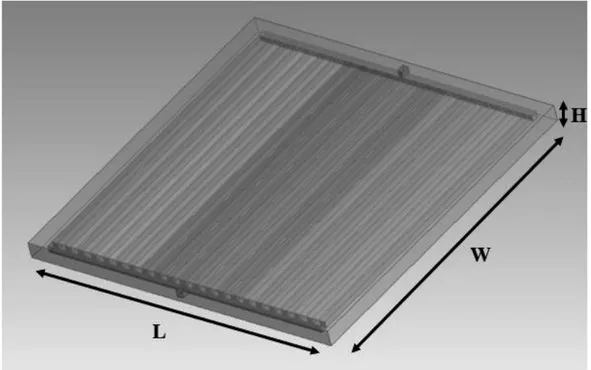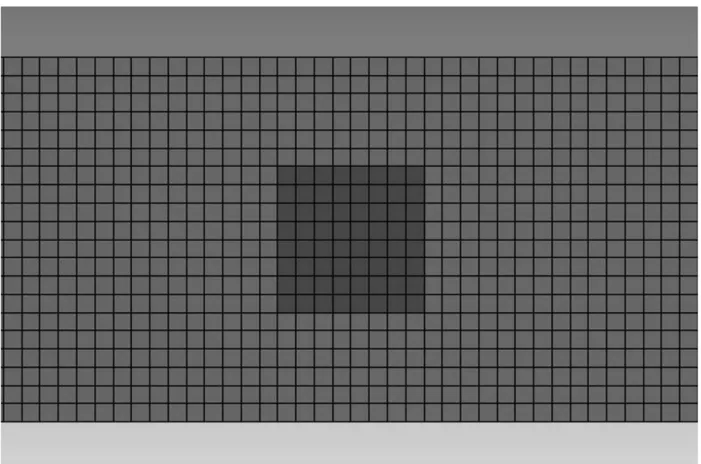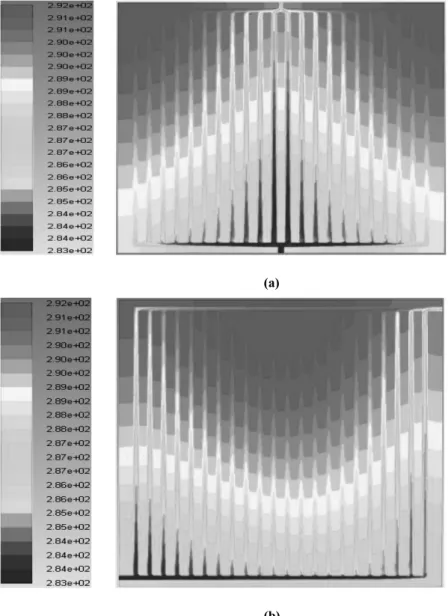1Aydın University, Department of Mechanical Engineering, 34295, Istanbul, TURKEY
2Istanbul Technical University, Institute of Energy Science and Technologies, 34469, Istanbul, TURKEY *Corresponding Author: mahditabatabaei@aydin.edu.tr
Numerical Investigation Of Heat Transfer In A Cold Plate With
Two Different Inlet Location
Mahdi TABATABAEI MALAZI
1, Suha SENSOY
2,
Hasan Alpay HEPERKAN
1ABSTRACT
We need a uniform temperature distribution for obtaining higher performances from electronic devices. For cooling, mini-channel cold plates with coolant flow use electronic devices such asLi-ion battery cells and electronic chips. In this study, two different inlet locations were studied for the thermal management of a plate with constant heat generation. A commercial computational fluid dynamic software (Ansys-Fluent) was used for the simulation of Mini-channel cold plates with coolant flow and thus pressure drop, temperature and velocity distribution were investigated numerically. The effect of inlet location on heat transfer and temperature distribution was studied for laminar flow at two different Reynolds number (Re=500 and Re=1000). Water was used for the coolant flow of the cooling system. The numerical results show that changing inlet location causes temperature distribution to change at the same number of coolant channels in a cold plate.
Keywords: Heat transfer, Cooling plate, Coolant flow channel, Reynolds number
Introduction
The efficiency of electronic devices will be higher when the temperature of electronic devices are kept below the recommended temperature. A cooling system is important for getting optimum performance from electronic devices. The heat transfer capacity of PEMFCs type fuel cells are studied to determine the efficiency of multi pass serpentine flow field (MPSFF). Applying parallel multiphase serpentine flow brings more advantage than general type parallel serpentine in terms of uniform temperature distribution. On the contrary, this two serpentine types come up with a similar result in regard to pressure drop [1].The geometrical impact of a channel that varies such as triangular, circular and square, is examined regarding to heat transfer coefficients that depend on mass flux and average quality [2]. Comparison between multiple parallel-pass (MPP) micro channel which provides an adjustable flow rate and conventional parallel tube condenser applied for increasing condensation field and heat transfer efficiency by using two phase flows [3]. It is investigated that the characteristics of serpentine shaped cooling channel is recorded by using CFD in variety of plate geometry related to the width, length and route of the channel. In this study, the optimization converge which is restricted with the objective function of pressure gradient and temperature uniformity
is performed by a different serpentine channel scheme variation [4]. Mini channel embedded to lithium-ion battery is used to operate optimum temperature with the different discharge rates. The study is examined with both experimental and computational methods [5]. Three types of mini-channel exchangers including a parallel, tree shaped and hybrid constructed, are examined in terms of thermodynamic properties. Besides, tree type design data were obtained majorly with numerical and experimental methods [6].They give solution advice for the aim of cooling an electronic device with a micro-channels heat exchanger. Various Reynolds numbers and heat fluxes are being studied in order to get optimum value and channel types [7].The changing of the numbers of the mini-channel heat exchanger is studied in terms of heat transfer from plane with natural convection. While providing fixed operating temperature on a physical domain, the experiment is resulted with the flow rate and flow direction effect being in an inverse correlation [8].
In this study, we studied two different models; Model A and Model B, at two various Reynolds numbers for plate constant heat flux. The results of temperature distribution and the average temperature of outlet were obtained in this numerical solution.
MODEL AND NUMERICAL METHOD
Two different cooling plate models (Model A and Model B) with infixed rectangular cooling channels were studied, as shown in Figure 1. The number of coolant channels and distance between coolant channels are the same in Model A and Model B but the inlet location is different in these models (Model A and B have twenty-two parallel channels with 0.5cm distance between channels). The dimensions of cooling plate models are 212mm x 212mm x 10mm (Length x Width x Height) and the dimensions of channels are 4mm x 4mm, as shown in Figure 2. Aluminum for cold plate and water for coolant fluid are used for this cooling system. Velocity inlet, pressure outlet, adiabatic surfaces and a constant heat flux surface were applied for boundary condition in this study (Figure 3).
Figure 2. Structure of cooling plate.
Ansys-Fluent software program was applied for numerical solving commercial CFD solver.The conservation of mass, momentum and energy equation can be written as;
𝜕𝜕𝑢𝑢𝑗𝑗 𝜕𝜕𝑥𝑥𝑗𝑗= 0 (1) 𝜌𝜌𝑢𝑢𝑗𝑗𝜕𝜕𝑢𝑢𝜕𝜕𝑥𝑥𝑖𝑖 𝑗𝑗+ 𝜕𝜕𝜕𝜕 𝜕𝜕𝑥𝑥𝑖𝑖= 𝜇𝜇∆𝑢𝑢𝑖𝑖 (2) 𝜌𝜌𝑐𝑐𝑢𝑢𝑗𝑗𝜕𝜕𝑥𝑥𝜕𝜕𝜕𝜕 𝑗𝑗= 𝜕𝜕 𝜕𝜕𝑥𝑥𝑗𝑗(𝑘𝑘 𝜕𝜕𝜕𝜕 𝜕𝜕𝑥𝑥𝑗𝑗) (3)
Where u and x represent the velocity and direction vectors, 𝜌𝜌 is the density, P is the pressure, 𝜇𝜇 is the fluid viscosity, T is the temperature, k is the thermal conductivity, Δ is the Laplacian operator.
SIMPLE algorithm was used for the coupling of the continuity and momentum equations. The solution was limited when residuals of x-velocity, y-velocity, z-velocity and energy equations were observed below 10-6. Quad mesh was
applied for meshing in this numerical solution. Different mesh elements were tested for independent solution therefore 3,600,000 mesh elements were used for numerical solution (Figure 4).
RESULT AND DISCUSSION
We studied coolant fluid flows along the channels that were set into cold plate. Two models that have same conditions (number of coolant channels and distance between coolant channels)were selected in this study but the inlet of flow is different places. The inlet is in the center of bottom channel in Model A and the corner of bottom channel in Model B.The laminar flow at two different Reynolds numbers (Re=500 and 1000) was applied at a constant heat flux (q=50
W) of one surface and the other surfaces are adiabatic boundary condition. Surfaces temperature distribution were
shown in center plane section of cooling plate for Model A and Model B at Figure 5 and Figure 6. Results show that coolant flow is more effective in cooling center of cold plate in Model A than Model B at the same Re number. In the Model B coolant flow is more effective in cooling sides of cold plate than Model A at the same Re number.
(a)
(b)
Figure 5. Surface temperature distribution in cooling plate with constant heat flux (q= 50 W) for
(a)
(b)
Figure 5. Surface temperature distribution in cooling plate with constant heat flux (q= 50 W) for
Model A and Model B at Re=500.
The pressure drop is higher in Model B than Model A for the two Re numbers due to the geometry of model B causing this increase. The temperature distribution is different for the two models but the average temperature of coolant flow in outlet is nearly same for two models at the same Re number. It shows that coolant flow (water) gets the same average temperature at the outlet of the cooling system for both models (Table 1).
Re=500 Re=1000 Re=500 Re=1000 Re=500 Re=1000 Model A PInlet=26.5 Pa PInlet=83.7 Pa TInlet,ave=283.15
K (10℃) TK (10℃) Inlet,ave=283.15 TK (16℃) Outlet,ave=289.40 TK (13℃) Inlet,ave=286.17 Model B PInlet=34.5 Pa PInlet=93.1 Pa TInlet,ave=283.15
K (10℃) TK (10℃) Inlet,ave=283.15 TK (16℃) Outlet,ave=289.23 TK (13℃) Inlet,ave=286.15
Table 1. Results of the numerical model
Conclusion
The effect of flow inlet location is investigated with two different models (Model A and Model B) in a cold plate. The numerical simulations are carried out for the cooling plate at two different Reynolds numbers with a constant heat flux in a plate surface. The temperature distribution of the cooling plates is different for two models. The average temperature of the outlet is the same for two models. The results show that the outlet temperature does not change so much but temperature distribution changes in two models. We can use one of these models for different local cooling. Further studies can be done with a better design by changing inlet flow location in mini channels.
REFERENCES
[1] Baek, S.M., Yu, S.H., Namc, J. H. (2011). A Numerical Study on Uniform Cooling of Large-Scale PEMFCs with Different Coolant Flow Field Designs, Applied Thermal Engineering, 31, 1427-1434.
[2] Derby, M., Lee, H. J., Peles, Y., Jensen, M. K. (2012). Condensation heat transfer in square, triangular, and semi-circular mini-channels, International Journal of Heat and Mass Transfer, 55, 187–197.
[3] Ye, L., Tong, M.W., Zeng, X. (2009). Design and analysis of multiple parallel-pass condensers, International
Journal of Refrigeration, 32, 1153 – 1161.
[4] Jarrett, A., II Yong, K. (2011). Design optimization of electric vehicle battery cooling plates for thermal performance, Journal of Power Sources, 196,10359-10368.
[5] Panchal, S., Khasow, R., Dincer I., Agelin-Chaab M., Fraser R., Fowler M. (2017). Thermal Design and Simulation of Mini-channel Cold Plate for Water Cooled Large Sized Prismatic Lithium-ion Battery, Applied Thermal
Engineering, 122, 80–90.
[6] Yenigün, O., Çetkin, E. (2016). Experimental and Numerical Investigation of Constructal Vascular Channels for Self-cooling: Parallel Channels, Tree-shaped and Hybrid designs, International Journal of Heat and Mass Transfer, 103,1155–1165.
[7] Kurnia, J.C., Sasmito, A.P. (2011). Numerical Investigation of Laminar Heat Transfer Performance of Various Cooling Channel Design, Applied Thermal Engineering, 31, 1293-1304.
[8] Yutao, H., Zhonghao, R., Xinjian, L., Jiateng Z. (2015). Investigation of Power Battery Thermal Management by Using Mini-channel Cold Plate, Energy Conversion and Management, 89, 387–395.




